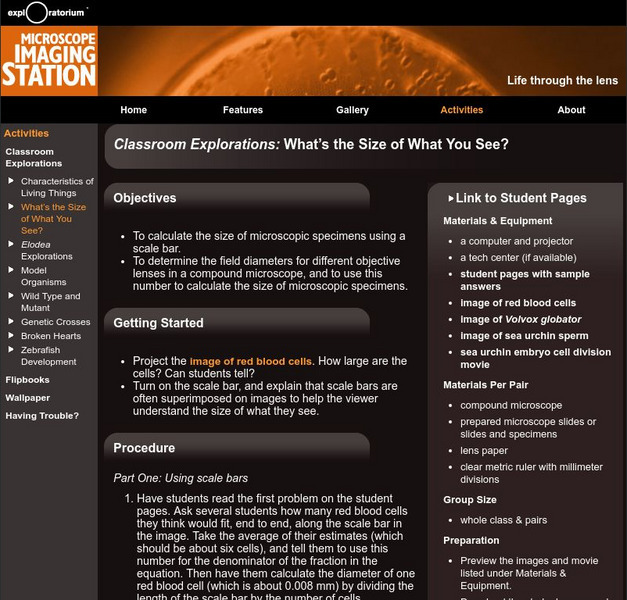Curated OER
CSI, Second Grade Style
Second graders conduct a classroom investigation. In this investigative lesson, 2nd graders spend their time observing, measuring, and collecting data. They simulate a forensic science lab by conducting a fingerprint, scent, footprint,...
Curated OER
Leaf Pack Study
Students conduct an experiment using leaf packs. In this leaf lesson students complete an activity in groups and complete a handout.
Curated OER
Organizing Organs
Fifth graders research plant and animals cells and create a Venn Diagram to show the similarities and differences.
Curated OER
Field Trip - Marine Science Institute
Students discover the ocean life of the San Francisco Bay. In this ocean activity, students take a Discovery Voyage of the Bay ecosystem through the Marine Science Institute. Also available are inland voyages, ocean labs, and tidepool...
Curated OER
My Favorite Biology Supplies
Here are some biology laboratory supplies that I can't live without.
Curated OER
The Grass is Always Greener
Third graders experiment with common grass and cellular division.
Curated OER
Crime Scene Investigation: Hair Analysis Lab
Pupils participate in a hair analysis lab. Using a digital microscope, students compare and contrast hair samples. They determine if the hair samples are human or animal. After completing lab results sheets, pupils share their...
Curated OER
Bioremediation
Students design and conduct investigations that illustrate the effect bioremediation has on organic matter and determine environmental applications. They, in groups, present their findings to the class.
Curated OER
Microorganism Multiplication
Seventh graders complete two experiments to learn about harmful and helpful microorganisms. For this microorganisms lesson, 7th graders read background information about fungi, yeast, and club fungi. Students then complete two...
Curated OER
Science Trail
Fourth graders explore the concept of ecosystems. In groups, they examine clues to find mystery objects. Once they find the mystery objects, they discuss what ecosystem each comes from. They also look at pond water samples under a...
Curated OER
Galloping Who?
Third graders do an Internet search to find out about Galloping Gertie and what caused the bridge to fail.
Curated OER
Mussel Movements
Students consider the impact of invasive species on local environments. In this ecology lesson, watch the video, Arizona Wildlife Views, which focuses on invasive species. Students develop vocabulary, relate to meaningful comprehension...
Curated OER
Cell Works
Young scholars identify the different parts of the cells and their functions. For this biology lesson, students create an analogy of a cell and its organelles. They make a poster and present it to class.
Curated OER
Water Molds (Oomycetes)
Students research a group of fungus-like organisms; the Oomycetes, by baiting them from natural sources (water and soil) and observing them.
Curated OER
Magnify It!
Students view objects of various sizes from several viewing distances to discover that their visual field is limited. They record what they see and compare their observations with classmates. They conduct more structured experiments.
Curated OER
Seeing Around Corners
Third graders build a periscope and experiment with it to determine how this tool helps them extend their line of sight.
Curated OER
Testing Termites to Discover
Students design an experiment to discover how termites respond to their environment.
Curated OER
Bioterror
Students explore and discuss October, 2001 anthrax attacks and their aftermath.
Exploratorium
Exploratorium: Microscope Imaging Station: What's the Size of What You See?
In this lesson, you use microscope images to show how to use scale bars to measure very small things.
Exploratorium
Exploratorium: Microscope Imaging Station: Model Organisms
Using model organisms is very important in scientific research. This lesson plan will help students see why the zebrafish, sea urchin, and fruit fly are commonly used.
Exploratorium
Exploratorium: Microscope Imaging Station: Mitosis Flipbook
Use this series of images depicting the process of mitosis in the early embryo of the fruit fly, Drosophila melanogaster to make a mitosis flipbook. In this stage of Drosophila development, nuclei divide very rapidly without cell...
Hunkins Experiments
Hunkin's Experiments: Mites
Hunkin's Experiments is a group of simple cartoon illustrations of scientific principles. Some would work well in the classroom, but others have little value beyond entertaining students. All of the projects are easy to do. In this one,...
Bio Topics
Bio Topics: Direct Observation of Yeast Population Growth
In this classroom lab experiment, students mimic optimal growth conditions for yeast, and with the help of a microscope, observe and record results using a cell counting method.






















